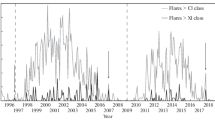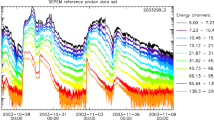Abstract
The correlation of flare’s location on solar disc with the value of sudden increase of total electron content is analyzed with flare’s parameters observed by GOES satellite from 1997 to 1999 and total electron content derived from GPS data observed by international GPS Service for Geodynamics. It is found that, besides the flare’s maximum X-ray flux, flare’s location on solar disc has some relation with the value of SITEC during the flare. The ionospheric response to a flare with a smaller maximum X-ray flux and nearer angular distance to the Sun’s central meridian line may be stronger than that of the flare with a larger maximum X-ray flux and far angular distance. To the flares with the same class of maximum X-ray flux, the nearer the angular distance to the Sun’s meridian, the stronger the ionospheric response.
Similar content being viewed by others
References
Thome, G. D., Wagner, L. S., Electron density enhancement in the E and F regions of the ionosphere during solar flares, J. G. R., 1971, 76: 6883.
Mendillo, M., Incoherent scatter observations of the ionosphere respect to a large solar flare, Radio Sci., 1974, 9: 197.
Ma Jianmin, Long Qili, The flare influence on ionospheric total electron content during flare on April 24, 1984, Journal of Space Sci., 1986, 6(4): 184.
Zhang Donghe, Xiao Zuo, The study of ionospheric TEC during the flare on Nov. 22, 1998 by means of 4 GPS receivers over China, Acta Scientiarum Naturalium, Universitatis Pekinensis, 2000, 36(3): 414.
Zhang Donghe, Xiao Zuo, Study of the ionospheric TEC using GPS during the large solar flare burst on Nov. 6, 1997, Chinese Science Bulletin, 2000, 45(19): 1749.
Matsoukas, D. A., Papagiannis, M. D., Anrons, J. et al., Corelation of solar radio bursts and sudden increases of the total electron content (SITEC) of the ionosphere, J. A. T. P, 1972, 34: 1275.
Mannucci, A. J., Wilson, B. D., Yuan, D. N. et al., A global mapping technique for GPS-derived ionospheric total electron content measurements, Radio Sci., 1998, 33: 565.
Zhang Donghe, Xiao Zuo, The calculating TEC methods by using GPS observations and its applications for ionospheric disturbances, Chinese Journal of Geophysics, 2000, 43(4): 451.




